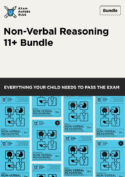
KS2 SATs Spelling Advice
Bookmark this page? Pop your email into the box below to receive a link to this article so you can easily refer back to it later.
Table of Contents
Introduction
The KS2 spelling paper has been designed to test the spelling ability of children in Year 6. The spellings in the test are taken from the current National Curriculum, and in particular, they’re an appendix to the main English curriculum, which outlines all the spelling rules and word groups children are expected to know by this stage.
The spelling element of the KS2 English SATs exam is delivered in the form of an answer booklet which contains twenty sentences, each missing a word. The teacher administering the test reads each word aloud, followed by a sentence that uses that word (which corresponds to the sentence in the answer booklet). The sentence is read again and there’s a short gap to allow the children to write their answers.
For example:
Spelling 1: The word is likely.
Sam is likely to play football at playtime.
The word is likely.
Children are given approximately fifteen minutes to complete the test, although this is not as strictly timed as the other tests.
The possible spelling patterns or rules that may be covered are diverse, as children in KS1 and KS2 are given extensive instruction and guidance on a wide range of strategies and rules. Listed below are some examples of potential spelling patterns or rules, along with some examples of each:
Common Exception Words
Common exception words are taught from Year 1 and don’t fall into any common spelling pattern or follow a particular rule. It’s usually harder to ‘sound out’ these words and so they’re often taught as ‘sight words’, or words that just have to be memorised in some way.
Examples: school, friend, father, nuisance, symbol
Adding Suffixes Beginning with Vowel Letters
This rule relies on the child recognising that the last syllable of the word is a stressed (or emphasised) sound. If the word also ends with a single vowel and then a single consonant, the final consonant is doubled before adding a suffix that begins with a vowel. The consonant is only doubled if the last syllable is stressed.
Examples: forgetting, beginner, preferred
The sound Spelt ‘Ou’
These words are common in our vocabulary and may be taught in separate groups, or as part of other spelling patterns.
Examples: young, touch, double, trouble, country
Words with the sound Spelt ‘Ch’
Again, these words may be taught discretely, or they may even form part of topic work, as many of them are Greek in origin.
Examples: scheme, chorus, chemist, echo, character
Words with the sound Spelt ‘Sc’
Many of these words have Roman origin, so they may also be taught as part of topic work. It’s thought that the original pronunciation of these words could have sounded the ‘c’ and the ‘k’ separately as ‘s’ and ‘k’.
Examples: science, scene, discipline, fascinate, crescent
Homophones and Near-Homophones
Homophones are words that sound the same as other words, but are spelt differently. They are tricky to master, and are one of the more difficult elements of the English language.
Examples: groan/grown, here/hear, heel/heal/he’ll, knot/not, mail/male, main/mane, meat/meet, medal/meddle, missed/mist, peace/piece
Words ending in –cious or –tious
These words are less common but are difficult to spell accurately – children often use the two endings interchangeably and therefore, they’re easy to get wrong. Usually, if the root word ends with –ce, the ‘cious’ ending is used, although there are exceptions to this.
Examples: vicious, precious, conscious, delicious, cautious, fictitious, infectious, nutritious
Words ending in –able and –ible
Generally speaking, the –able/–ably endings are far more common than the –ible/–ibly endings.
There are several rules to be applied when deciding on which ending is appropriate but, as with many spelling patterns in our language, not all of the spellings follow the rule and some simply have to be learned by heart.
Examples: adorable/adorably, applicable/applicably, changeable, noticeable, forcible, legible, possible/possibly, horrible/horribly
There are obviously many more spelling rules to be learnt over both Key Stages. Children should be encouraged to look for patterns, devise ways of remembering words that don’t follow any rules and recognise words that they know how to spell within their reading books. Grouping words that follow a particular rule, devising personal spelling dictionaries and rewriting words are just a few ways to help children develop their spelling abilities.
Our SATs Resources

At Exam Papers Plus, we publish SATs practice exam papers for children at KS1 and KS2 level. The practice tests cover every aspect of the exam process including Mathematics, Reading and English grammar, punctuation and spelling (SPAG). Each practice paper also comes with a full mark scheme so you can check your child’s answers and monitor their progress.
SATs practice papers are a great way for students to familiarise themselves with the layout of the exam and to get used to the types of spelling questions they may be asked. These practice tests are completely up-to-date to match the style of the new SATs examinations in line with the recent changes to the National Curriculum. They’re also reviewed and updated regularly to ensure their accuracy and relevancy.
Key Stage 1 SATs: Practice Test 1
Key Stage 1 SATs: Practice Test 2
Key Stage 2 SATs: Practice Test 1
Key Stage 2 SATs: Practice Test 2
For additional spelling practice, you may also want to try our 11 Plus English Spelling pack. This set of practice tests can provide a more challenging resource for children at KS2 SAT level.
Related posts:
The SATs Reading Comprehension Test: What You Need to Know
Bookmark this page? Pop your email into the box below to receive a link to this article so you can easily refer back to it later.
















